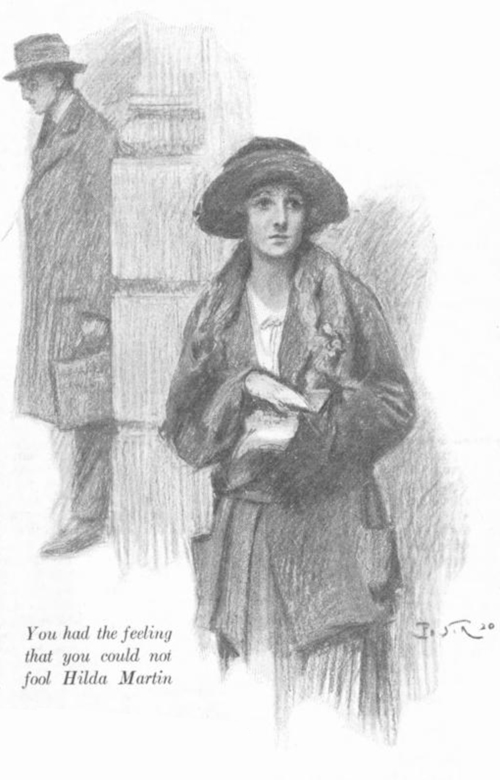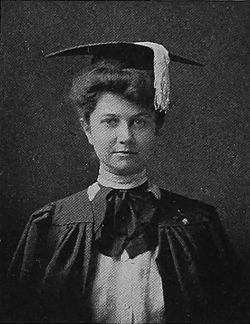putterings 429 < 430 > 431 index
a place for his “tools,” and he knew little
One afternoon Benton Hoyle was surprised to have his aunt’s niece come to him with an unusual curiosity concerning the details of finance which she never before had shown. He was embarrassed, first because she came upon him in his carpenter’s shop, a place where he did not like to be followed. It was several years since he had spent much time there, but he had gone so far as to have a room in the fourth story of [205] the old-time high-shouldered Boston house set apart as a place for his “tools,” as Mrs. Hoyle called all his equipment, indiscriminately. And on this rainy afternoon he had, breathlessly, ascended to it. Christina found him puttering over the model of the wing of a “flying machine.” He always used that old-fashioned term, and he knew little of modern models. Laboriously, more than once, he had worked out independently a crude idea that long since, unknown to him, had been perfected.
Christina, looking around the dull, cluttered, dusty room, smiled strangely, but made no comment. If she was reminded of Amos Fortune’s remark about a man’s hobby she gave no sign. But she suddenly had a more kindly feeling than usual toward her uncle. She did not, in truth, know that this warm kindliness was due to the sudden twinge of pity at the remembrance of the story of Amos’s brother, who made the little airplane that flew once across a green meadow, and then broke.
“Uncle Benton,” she began, somewhat timidly, for Christina disliked to show ignorance, “is there any way of finding out who bought stock that was sold some time ago?”
—
Sylvia Chatfield Bates, The Golden Answer (1921) : 205
NYPL copy/scan (via google books) : link
same (via hathitrust) : link
first landing at
“The Golden Answer,” Part two, illustrated by B. J. Rosenmeyer
Woman’s Home Companion 48:3 (March 1921) : 21-25, 56ff (70) : link
Part one, 48:2 (February 1921) : 7-11, 63ff : link
Part three, 48:4 (April 1921) : 21-23, 101ff : link
—
It is to Boston that the Hoyles have retreated, after certain reverses in their investments; flying machine models make several appearances in the novel, all of some importance — “I think you can judge a man not by his business in life but by his hobby...” (p86), “his divine fooling” (182).
For the author’s account of the development of this novel over a period of six years of “week-end work,” see
Sylvia Chatfield Bates, “The Growth of a Novel” in The Editor (“The Journal of Information for Literary Workers) 55:6 (September 24, 1921) : 49-51
Princeton copy/scan (via google books) : link
same (via hathitrust) : link
from which —
“I consider that the book gained more than it lost by the necessity of slow work. Simmering thus in my mind, perforce it grew: the outline expanded beyond the original plan; characters were added. Just as, through the workings of the subsconscious mind, one is better able to solve a mathematical problem after ‘sleeping on it,’ so I found that my story was growing while I was away with it, apparently without my volition. .. I am glad I was forced to go slowly with this particular book.
“So much for the matter of time...”
and —
“It is so often true, too, that a man of ‘Amos’s’ calibre does not marry the woman who would make him happy, even though she is directly under his nose, that I created ‘Hilda’ to fill that part. Or not that, exactly — ‘Hilda’ created herself because she was the one who really loved ‘Amos’ as he should be loved. I will admit that in real life I think there would have been no ‘C. M.’ for ‘Hilda.’ He was a sop to Cerberus, both editorial and personal.
“And so it went...”

illustration by B. J. Rosenmeyer (1879-1943 *), in Woman’s Home Companion 48:2 (February 1921) : 10 : link
aside —
wondering just how personal that Hilda was, to Sylvia Chatfield Bates.
I have lingered in this novel, backwards and forwards and back again from the initial landing at the word “puttering” — for its characters and their romances, and for its acute and seasoned observations about the complexities of motives and of living. I wonder too what Susan Glaspell might have done with its premise — probably taken the story out beyond its principals and into the impact on Amos’s (adopted) Harmony in later years.
![]()
Sylvia Chatfield Bates (1882-1968)
I have not encountered a lot about Bates, but here is a start.
- Bates, Sylvia Chatfield (1882-1968). American author and professor.
Born in Hartford, CT, Bates graduated from Elmira College in 1905 and was a teacher in Schenectady, NY, when her first book, Elmira College Stories (1911), appeared. She did graduate work at Radcliffe College and published several novels while working as an editor at the Woman’s Home Companion. In the 1930s she began teaching creative writing in the journalism department of New York University, where Carson McCullers was her most notable student. Cather seems to have first met Bates at the Bread Loaf School of English in 1922 and maintained a cordial relationship with her as a Greenwich Village neighbor.
from note to communication #0612: Willa Cather to Sylvia Chatfield Bates, [August 10 to September 11, 1922], at
The Willa Cather Archive : link (accessed 20240521)

portrait in Elmira College yearbook (1905)
the accompanying text reads:
Sylvia Chatfield Bates. Schenectady, N. Y.
“Bats,” “Sylviah.” Κ Σ, Thespis, Lit. Ed.
Iris, V. Pres. (1, ’06) Sibyl Board, Prop. Mgr. Thespis.
“’Twill wish you well — the looking glass,
And look you in the face to-night.”
Passing fair, stately and tall — “I hate a dumpy woman” ‐ with cute curls, innocent blue eyes and a shy, retiring manner. Reared in ignorance up to the time she reached Elmira — then learned how to pronounce her own name. A wonder at writing short stories, but wishes they could find some one else to be the “butt of the Sibyl.” Can blush when especially requested, but was recently outdone in a match for the displayal of this particular evidence of innocence.
from The Furrowed Middlebrow (blog), “The Americans : B’s (3 of 4)” (June 16, 2018) : link
- Sabrina Ehmke Sergeant discusses Bates’s novel The Vintage (1916) in her dissertation Mobilizing sentiment: Popular American women’s fiction of the Great War; 1914–1922 (University of Nebraska–Lincoln : 2011) : 16, 34-41 :
link (pdf)

- books authored by Sylvia Chatfield Bates (including links to online versions as of 20240522)
Elmira College Stories (1911) : link (hathitrust)
The Geranium Lady (frontispiece by R.M. Crosby; 1916) : link (hathitrust)
Vintage (frontispiece by Paul Julien Meylan; 1916) : link (hathitrust)
The Golden Answer (1921)
Andrea Thorne (1925)
That Magic Fire (1928) : link (archive.org)
I Have Touched the Earth (1934)
Long Way Home (1937) : link (hathitrust)
Floor of Heaven (1940)
Weather Breeder (1948)
Silver Yoke (1951)Twentieth Century Short Stories, selected by Sylvia Chatfield Bates (1933) : link (google books)
Moby Dick by Herman Melville, adapted with notes and glossary by Sylvia Chatfield Bates; Foreword by John H. Finley; Illustrated by I. W. Taber (1928)
Stanford copy/scan (via google books) : link - Sylvia Chatfield Bates, online book page : link